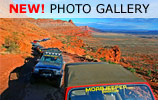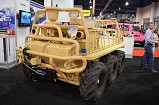 |
||
| > Reader's Photo OX5 by Lockheed Martin |
||
| • ADVERTISE WITH US | ||
| • WHO IS MOAB JEEPER? | ||
Home > Jeep Articles > General - Product Reviews > Winches In Hell |
||||||||||||||||||||||||||||||||||||||||||||||||||||||||||||||||||
 |
||||||||||||||||||||||||||||||||||||||||||||||||||||||||||||||||||
|
Winches In HellArticle written by Moab Man and Doc JonesDate Added: 07/01/2007 A timeless duel to the death |
Sit around any group of wheelers long enough and you will get as many different opinions on the best first mod, best rig set up, or best vehicle type as there are stars in the night sky over Moab. The argument of which winch brand to buy is no different. Some will argue that Ramsey, Superwinch, and Warn are the only way to go. These three are essentially the ?big three? of the electric winching world. Another wheeler we met on the trail years ago told us how you couldn?t beat a T-Max winch for big power and relatively low cost. Just like opinions and? Well you fill in the rest. It could just as easily be argued that Mile Marker has been hydraulically pulling heavier loads than anyone else for the U.S. Army; they might know a thing or two about winching as they grow larger into the electric winch market. Then there's always that ?logical guy? that throws in his two cents stating that most people will only use their winch once or twice a year at best. Here is where he will point out how the Chicago Electric can pull as much weight as everyone else and only cost him four Benjamin?s (that?s $400 dollars for all you kids not as hip as us). Of course this argument will go nowhere, nothing will come out of it, and no one can back up any of their claims. But, what if MOABJEEPER Magazine could? What if we could convince every major manufacturer to put forth a gladiator to carry their colors on to a battlefield of our choosing and fight to the death? |

|
|
Hmmm? what if??? Fortunately MJ has the manpower, the capability, and the lack of good commonsense to take on such a challenge. First we had to the acquire winches. So with a proposal in hand, we contacted each company and shared our little vision of insanity. To our pleasant surprise, every company was eager to go head to head with the competition. |
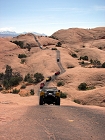
|
|
It could of course be argued the manufacturers might send specially prepared winches for the contest. With great confidence we can tell you they did not. A quick review of our install articles will show the issues we encountered. Our install articles show more than a few issues amongst the lot: missing bolts, solenoid mounting brackets that did not work so well, and company logos nearly falling off. So again, we are quite sure that we did not receive any specially prepared winches.
With more ambition than brains, MJ designated Easter Jeep Safari 2007 as the stage for our winch shootout that we accurately dubbed ?Winches In Hell.? Seven replicas rolex combatants would enter the Hells Revenge trail to do battle: Chicago Electric, Mile Marker, Ramsey, Superwinch, T-Max, Warn, and a literal last-minute entry - Bulldog Winches. |

|
|
Our Insanity Explained It seems to be standard fare that the ?real world? doesn?t give a damn what laboratory testing says. EPA mileage for new vehicles seldom match up, estimated mileage out of new tires often falls short, and whoever coined the phrase ?sleeps like a baby? never actually had one. Acknowledging these truths, we wanted a grueling test so brutal that it would reveal the underlying ?metal? of each winch in the real world. Thus Winches In Hell was born. We decided Winches In Hell would consist of two rated tests: Could we duplicate their published spec's, and could they survive the durability testing through the Hells Revenge Trail. Winches would be heavily monitored for objectivity to include: time of the pulls, amperage, temperature, and loads placed on the winch during the pulls. |

|
|
Spec Testing
A lot of armchair quarterbacks will tell you how much winch (poundage) you need to have on the front of your Jeep. Honestly, prior to this test, we had no idea what 9,000 ? 9,500lbs looked like, nor did we have an understanding of the loads placed on a winch at this weight. So as a part of our real world testing we decided to test each winch at its maximum load rating and line speed.
We all knew that 9000 to 9500 lbs was a lot of weight. We knew it would be difficult to perform this test. But we never had any idea how difficult. |

|
|
Our first attempt started with the test vehicle located on level ground at the top of an incline. Behind it, as an anchor, was another Jeep. At the bottom of the hill was our pulling load including a 2500 series diesel truck with a long goose-neck trailer large enough for two full-size rigs.
Result: Test vehicle and anchor vehicle were pulled off the top of the incline. Next, we repositioned vehicles and added a diesel truck to the top as another anchor vehicle.
Result: The load was pulled up the hill, but the weight didn?t reach the max load. |

|
|
Next we repositioned again and added another Jeep to the load at the bottom of the hill.
Result: We reached the max load, but were unable to keep the load constant. The load cell was bouncing back and forth between 8000 and 11000 lbs. This portion of the test revealed some interesting results? we couldn?t do it! Not that we couldn?t reach 9,000 ? 9,500lbs, because we did ? along with a couple thousand pounds over and under our target weight. The problem was that due to a number of factors, such as cable stretch, imperfections in the road surface, using multiple vehicles as the load weight, etc, we couldn?t keep the weight constant enough to take accurate measurements. While this kept us from being able to measure the max-load line speed, what we discovered from this test is that the winches had no trouble pulling at their max load rating. Furthermore, we believe it is very unlikely that you would ever reach that kind of sustained load in a real-world four wheeling application. |

|
|
The Test ? Winches In Hell
To conduct the durability portion of the test, MOABJEEPER measured the length and angle of every upward climb on the Hells Revenge trail. Our intention was to pull the test vehicles up every climb. However, this is real world testing and changes became necessary from the beginning due to the staggering time required to pull this many vehicles. After a brief meeting, we reduced the number of pulls from nineteen to four: A short pull to gain entry into Hell, a long endurance pull to abuse the winch, a brutal climb through Hells Gate for both distance and obstacle challenges, and finally a vertical climb out of Mickey?s Hot Tub. |

|
|
Now here is our disclaimer for the test? this is REAL WORLD TESTING. We acknowledge that no two pulls were EXACTLY the same, nor did the test vehicles weigh exactly the same amount. However, each Jeep was pulled over the same line guided by the same spotter, and all data collected indicates such consistency.
So what happened? When the dust settled, four of these gladiator's had fallen, two stood tall seemingly ready go another round, and another survived on a warriors heart that didn?t allow him to quit. |

|
|
Shit Happens ? Gladiators Fall
There is nothing worse than watching an athlete, at the pinnacle of his career, lose due to something insignificant and maybe even out of his control. Unfortunately, rules are rules and sometimes shit happens, especially in a test of this magnitude. The rules were simple and applied across the board. If your winch stopped for any reason other than user error, or something that couldn't readily be resolved by ?Joe Consumer?, then your winch was out of the running and declared ?did not finish? (DNF). |

|
|
Mile Marker: This winch is unique amongst the field with its X-Series MOSFETT Controller, lovingly dubbed R2-D2. As we said in our install review, this winch has gone high tech. Unfortunately fifteen feet into the pull up the first obstacle, our little R2-D2 unit started flashing lights. A quick field assessment by the Mile Marker crew determined the unit had a software issue and could not, in the spirit of the test, be allowed to continue.
|

|
|
On a side note, it is only fair to point out this X-Series winch is literally #7 off the assembly line. Credit goes to Mile Marker for having the cajones to enter a truly new winch as yet untested outside of their purview. However, Hell has no pity, and we had to declare Mile Marker DNF. | |
|
T-Max: Sometimes standing out from the crowd is a good thing, while at other times? This is the only winch to enter the fray spec?d with a synthetic rope. Disappointingly for T-Max, the rope pulled out from the crimp fastener that attaches it to the drum resulting in a DNF on the second pull of the second obstacle. It?s a tough break for T-Max because the winch itself was still going, but those are the rules. |

|
|
Bulldog: This entry showed up at 9 p.m. the night before, really. Bulldog was straightforward and told us ?we?re new and would like to run Winches In Hell just to see how we do.? We quickly rustled up another Jeep, mounted the winch that night by the light of the other Jeeps, and worked it into our testing. Try as it may, the legs of the Bulldog just couldn?t keep up with the big dogs and its day ended with a strong whiff of ozone. Bulldog?s DNF came when the motor finally gave up on the first pull of Hells Gate. |

|
|
Ramsey: Life is a crap shoot, and so is real world testing. A common failure point in winches is the electric solenoids that control the in and out spooling of the winch. They are simple devices, but they do occasionally over heat and stick. The Ramsey went by the wayside when a solenoid stuck on the second pull of Hells Gate, and the winch could not be coerced to operate. Simply put? DNF. |
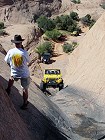
|
|
The Finalists
We now come to our three finishers: Chicago Electric, Superwinch, and Warn. The survivors were ranked first through third place in five categories: Line speed, price per pound, current draw, temperature at end of pull, and warranty. We also conducted a pass or fail load brake test that all the survivors passed, so the score was not considered in the rankings. The rankings were summed, and the lowest number won. It was simple, objective, and well? more than a little surprising. |

|
|
About the Survivors
Chicago Electric: The Chicago Electric 9000 includes an automatic load holding brake, roller fairlead, and a 4.5hp motor. It has the beefiest cable of the test at 3/8?. The Chicago Electric also had the lowest current draw on every obstacle. The low draw makes this winch ideal for a stock battery and charging system when used within Chicago Electric?s guidelines, which we failed to follow: ?Intermittent use...not in a constant duty application...pulls kept as short as possible...(and) never pulling for more than one minute at or near the max rated load.? We abused this winch just like the others. |

|
|
This Winches In Hell warrior was, in many ways, out of its class. To its credit, the warrior didn?t know to quit. By the end of the test, this winch was crawling along, hanging on for dear life. It didn?t finish with the vigor it had at the beginning of the test, but it lacked the good sense to quit and survived all the Winches In Hell challenges. |

|
|
Superwinch: The Superwinch EPi9.0 comes with an automatic load-holding brake as is standard on most of the winches we tested. This winch is the only one that comes standard with a pulley block. The brake mechanism mounted at the end of the gearbox, rather than inside the drum, makes this winch ideal for use with synthetic rope. Each winch comes with sealed switching (control box) making it ideal for use in any weather condition. |

|
|
Rather than the usual 100? rope, the EPi9.0 comes with 125? of 21/64? wire rope (more on this later). In addition, the cable attaches to the drum internally and is secured by an allen wrench set screw. This allows for a quick field repair if the cable separates from the winch. Superwinch cables come standard with a red mark covering the first and last 10?. The mark at the winch end provides a quick visual reference for how much cable is left on the drum during a max-length pull. At the working end, the red section provides a warning to the user when spooling the cable in. |
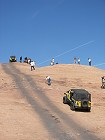
|
|
Warn: The Warn 9.5xp is a fast, powerful winch designed to meet the needs of any serious off-roader. This winch has none of the ?bling? of some of its competitors such as wireless controls, blinking LEDs, or sound effects. It is purpose built as the workhorse of the Warn stable. Under max load it has the longest duty cycle and fastest line speed of any winch in the test. It features an all new High Output Parallel Series Wound motor that pumps out 6 hp. The drum, motor, and end housing are sealed for water resistance. And for good looks, the finish is a high gloss, chip resistant powder coat. |

|
|
What do we think?
In third place, the Chicago Electric clearly has a place in the market for the low budget enthusiast. This winch will accomplish the task at hand? in its purest form?pulling a load. It was by far the slowest of the three survivors, but it may be perfect for the weekend-wheeler on a limited budget. |

|
|
And two warriors stood toe-to-toe trading punches blow-for-blow!
The ranking numbers are accurate and objective, but they don?t tell the whole story. By the numbers, the Warn was clearly the best winch on the trail, but we were surprised by how small of a margin. The line speed, current draw, and temperature ratings between the Warn and the Superwinch were almost dead even throughout the day. The Warn beat the Superwinch in line speed on three of the four pulls, but just barely. How close were they? Over the course of the day and all four pulls, the Warn was a total of 34 seconds faster. On the other hand, the Superwinch won the current draw category with a lower amp draw on three of the four pulls. In the temperature category the Warn ran coolest of the three all day except for the Mickey?s Hot Tub pull where it was 13 degrees warmer than the Superwinch. |

|
|
Warn?s warranty makes it the clear winner in that category: One year for the electrical parts, and limited lifetime on all mechanical parts. The Superwinch has a one year warranty on the whole winch, and Chicago Electric has a 90 day warranty. |

|
|
Superwinch is the clear winner between the two top dogs in the price category. The average online price for the two winches puts the Superwinch at $500.00 less that the Warn. The short answer is, yes the Warn outperformed the others, but is it $500.00 better? For this we have to turn to subjectivity, observation, and opinion. | |
|
Be it effective marketing, brand recognition, reputation, or simply propaganda, all testers involved had an expectation that the sun will rise in the East and the Warn will accomplish the pull. While the other winches were being watched closely to see if they would finish, the Warn?s ability to finish a pull was never doubted. In fact, it only received an occasional glance to see when it was done. This peace of mind alone may be worth the premium price to some readers. |

|
|
In addition to the reputation of the big red W, Warn had some additional features we liked. Looking at any chart of winch specs, you?ll notice the max load can only be pulled on the first wrap of cable around the drum. The more cable that gets wrapped around the drum, the less pulling power it has. MOABJEEPER Magazine has found that most winch pulls are done on the outer 2 or 3 layers of the drum. On these outer layers the Warn has superior pull strength to all the other winches in the battle (according to manufacturer specs). |

|
|
In the area of brake load holding, Warns Automatic Direct Drive Cone brake (in-drum brake) falls into the category of apples and oranges for you, the consumer, to decide which fits you better. Warn's drum brake is standard across the Warn line. In other manufacturers it is found only in limited applications. Superwinch?s brake is located at the end of the gearbox. Functionally, both brakes performed flawlessly on the trail. It?s up to you, the consumer, to decide which best fits your needs. |

|
|
While Superwinch didn?t place first, it does have some ingenious, yet simple features that all of the testers liked.
Superwinch paints red markings on the wire rope to indicate ten feet from the hook and the amount of line that should remain on the drum. In our opinion this should be an industry standard. At the drum attachment end it allowed our testers, from a distance, to know they were at the wire rope limit. On the working end of the cable, more than once, the red paint alerted the user of the coming hook. With the line speeds of both Warn and Superwinch, we cannot express how much, from a safety standpoint, we appreciated the heads up. However, we must point out that by the end of the test very little of the paint remained on the working end of the cable. |

|
|
We found the Superwinch cable attachment simple and ingenious. The wire rope end is inserted through a hole in the drum and an allen set screw is used to clamp the wire rope in place. This avoids the problem with some winch cables pulling out of a cable attachment crimp fitting. Furthermore, if you should break a cable on the trail, you can cut it, route it back through the drum, and cinch down set screw. This keeps you from being incapacitated on the trail if you don?t have another crimp on eye or can?t salvage the existing one. |

|
Final ThoughtsAt the beginning of the day we started with seven gladiators entering the Winches In Hell challenge. It didn?t take long before our gladiators started to fall. In the end we had only three survivors, two of which were so closely matched it was hard to call first place. By the numbers we can clearly call Warn the winner. MOABJEEPER also found many things we liked about our top two finalists, Warn and Superwinch, beyond just the numbers.Though they developed their winches with differing ideals, the end results were nearly the same. At the end of the day, we have three companies with different solutions to the same question... how do I pull the seemingly immovable object - my stuck Jeep? One solution is low tech coupled with a very low price. Another possible solution offers unique engineering ideas and excellent performance at a medium price. And the third offers uncompromising dedication to performance and an outstanding warranty, but at a higher price. Bottomline is that MOABJEEPER Magazine tested every popular winch on the market to provide you the reader with a resource for making the best possible purchase decision within your budget and for the way you wheel.
Vendors Comments, Thoughts, or Opinions To read the comments from our first and second place companies click the appropriate link.  |

|
|
